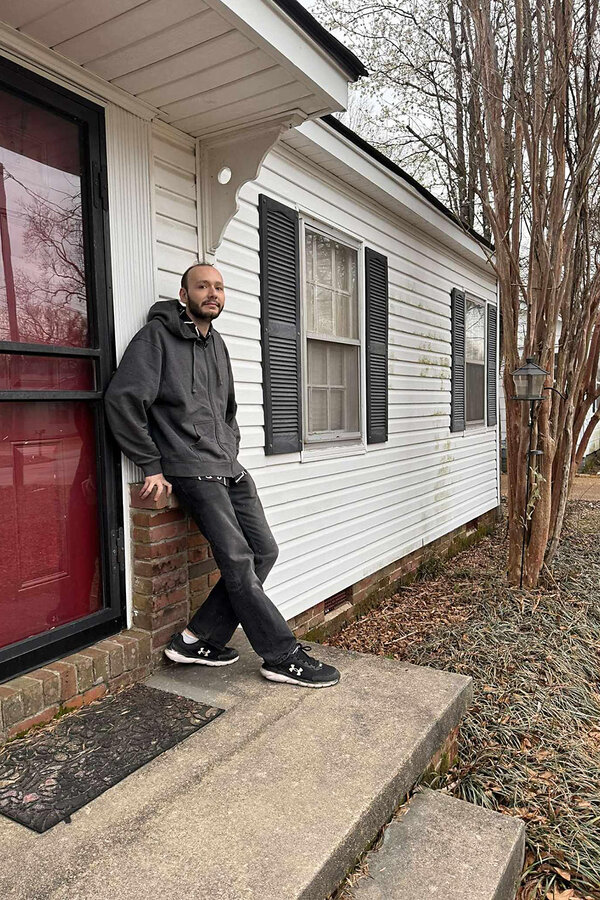Millennials tiptoe toward better chance for homeownership
Loading...
Michael Alas is thinking about buying his first home. It depends, in part, on whether he lands a job that he’s interviewed for. It would mean more money and a move – from rural Mississippi where he works as a college recruiter to the state capital, Jackson.
Like a lot of millennials, the 30-something Mr. Alas is slower than people in prior generations to pursue this piece of the American dream. Nevertheless, hopes are on the rise that an extraordinarily tough housing market is finally about to ease.
Why We Wrote This
A story focused onMortgage rates are down a full point since peaking last October – raising hopes that an extraordinarily tough housing market is finally about to ease, a boon for those eager to build wealth through homeownership.
Mortgage rates are down a full point since peaking at a two-decade high last October – and are expected to fall further as the Federal Reserve begins cutting interest rates later this year. Falling rates should convince more homeowners to sell and more homebuyers to buy. Last month, more homes came on the market than in any four-week period in three years.
Still, the adjustment is likely to be slow. And the longer this adjustment takes, the greater the wealth gap between current homeowners and young adults who can’t afford to buy a home. This gap yawns widest for low-income renters and people of color, trends that threaten to make America’s existing wealth disparities even greater.
Michael Alas is thinking about buying his first home. It depends, in part, on whether he lands a job that he’s interviewed for. It would mean more money and a move – from rural Mississippi where he works as a college recruiter to the state capital, Jackson.
“I never thought I’d even consider this,” he says. But “I realize it is more of a possibility than it was last year and the year before and the year before that.”
Like a lot of millennials, the 30-something Mr. Alas is slower than people in prior generations to pursue this piece of the American dream. Nevertheless, hopes are on the rise that an extraordinarily tough housing market is finally about to ease.
Why We Wrote This
A story focused onMortgage rates are down a full point since peaking last October – raising hopes that an extraordinarily tough housing market is finally about to ease, a boon for those eager to build wealth through homeownership.
Mortgage rates are down a full point since peaking at a two-decade high last October – and are expected to fall further as the Federal Reserve begins cutting interest rates later this year. Falling rates should convince more homeowners to sell and more homebuyers to buy. Last month, more homes came on the market than in any four-week period in three years, according to real estate brokerage Redfin.
Still, the adjustment is likely to be slow. Mortgage rates may not come down by much this year. Construction companies aren’t building enough new homes to satisfy demand. And many young adults are still struggling to pay off student debt.
The longer this adjustment takes, the greater the wealth gap between current homeowners and young adults who can’t afford to buy a home. This gap yawns widest for low-income renters and people of color, whose parents typically can’t help with down payments. These trends threaten to make America’s existing wealth disparities even greater.
A decline in mortgage rates “will certainly improve affordability for some households,” says Carolina Reid, professor of city and regional planning at the University of California, Berkeley. But “the age and the wealth and the income disadvantages all intersect and are particularly pronounced for Black and Hispanic households.”
Coleman Hemsath, 31, is one of the fortunate ones. After paying some $3,000 a month for a small place in Manhattan, he and his partner moved recently into a two-bedroom house in Jersey City, New Jersey. “We were in a cramped apartment,” he says. “We have a dog. It was time to get serious – [and] also a yard.”
In many ways, Mr. Hemsath is ahead of his generation. Younger than the average first-time homebuyer – who is 35, the National Association of Realtors reported last year – he has more time to take advantage of home price appreciation and tax deductions to grow his wealth. A 2018 Urban Institute study found that those who bought a home before age 35 amassed nearly twice the housing wealth of those who waited until later to purchase their first home.
Kenji Jimenez, a renter in Pomona, California, falls in the latter category.
It’s not for lack of effort. In his early 40s, Mr. Jimenez has been looking for two years and has worked hard to improve his credit rating. Even though rent consumes nearly half his $40,000 income, he has cobbled $30,000 to $35,000 together for a down payment.
But given that he lacks a co-signer, his income is too low to qualify for a bank loan for the $450,000 to $500,000 homes he’s looking at. And he has no relatives with the financial wherewithal to co-sign. But this father of three teenagers remains determined.
“Might as well try to transition over,” he says. “I’d rather struggle on my own dime.”
The delay for first-time homebuyers has been building for some time. Three decades ago, nearly half of 25-to-34-year-olds owned a home. Now, it’s fewer than 1 in 3, when measured on an individual basis, according to an Urban Institute study last year. By focusing on individuals rather than households, which the U.S. Census Bureau considers, the study exposes an additional trait of millennials: They’re not forming households at the same rate as their parents.
Instead, they’re living with parents, relatives, or friends, delaying marriage and children. “It’s part inability” for financial reasons, says Michael Seiler, real estate and finance professor at William & Mary in Williamsburg, Virginia. “But it’s also a lack of desire. ... Homeownership is the American dream? I don’t think young people share that philosophy.”
This change comes against a backdrop of two decades of dramatic tumult in the housing market that is unprecedented in postwar America, says Professor Reid of UC Berkeley. Home prices soared in the easy credit era of the early 2000s, crashed after the 2007-2009 financial crisis, and then soared again when mortgage rates fell to near-record lows. As late as 2022, homebuyers were scrambling to snap up homes before mortgages climbed too high.
High mortgage rates then hit the housing market with a double whammy. Not only did they prevent first-time homebuyers from buying, but they also discouraged older sellers from selling. Having locked in a low mortgage rate on their current home, would-be sellers didn’t want to buy another home with a higher interest rate.
Now that mortgage rates have eased a bit, more buyers are emerging, but their composition has changed, says Jung Hyun Choi, a principal research associate at the Urban Institute. They have higher incomes, more education, and a greater ability to put down more than 20% on a house.
“The market was slower, but as of mid-February, the market has been crazy,” says Francesca Lampert, a real estate agent in Menlo Park, California, where the median sales price tops $2 million. “We’ve had a lot of buyers the past two weeks reaching out, ready to jump into the market. They say, ‘We don’t care. ... We need to jump in, and get a piece of this action, and start building equity for ourselves, despite interest rates.”’
Another plus: House-flipping, the purchase of homes for remodeling and quick resale, which surged to new highs in 2022 and drove up home prices, especially at the lower end, has fallen dramatically.
Eventually, some experts say, the market should adjust to allow more than only high-earning millennials to afford their first home. The gap isn’t just financial. The affordability crisis has hit people of color especially hard, with 37% of Hispanic and 39% of Black renting households priced out of a median-priced home between March 2022 and March 2023, according to a study last summer by the Joint Center for Housing Studies at Harvard University.
The challenge is that the longer the market adjustment takes, the more inequality the current imbalance creates.
Cities are looking to boost supply by loosening zoning rules on new home construction, although so far, restrictions on new housing keep getting tighter, says Professor Seiler.
“We need more targeted policies on the demand side,” says Ms. Choi of the Urban Institute. She points to assistance programs to help first-time buyers with down payments and credit programs that target specific neighborhoods or areas. Although federal legislation has stalled in Congress, some federal and state agencies target assistance for certain geographies or help renters establish credit through rental payments.
Last year, Gio Tundo bought his first home in Cleveland, Mississippi, with no down payment, thanks to a rural development loan through the U.S. Department of Agriculture, his employer. The 20-something biological sciences technician also qualified for a low-interest loan, which made payments on his $100,000 home as cheap as the cost of renting a place, he says. “I’m in a pretty decent situation.”










